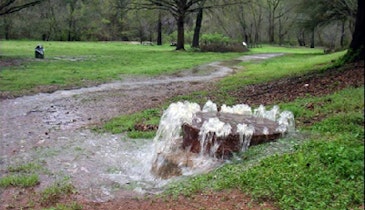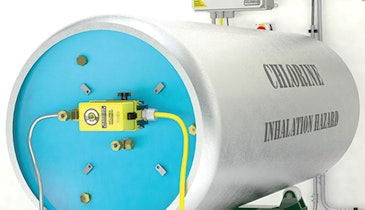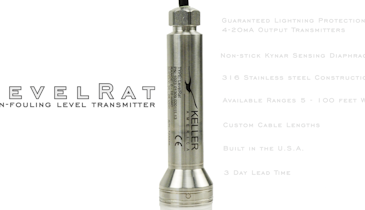Interested in Headworks?
Get Headworks articles, news and videos right in your inbox! Sign up now.
Headworks + Get AlertsScrew press efficient in dewatering membrane bioreactor biosolids
Problem: The Decatur (Arkansas) Wastewater Treatment Plant’s dewatering technology was undersized and inefficient. With the added demands of a plant upgrade, the operations staff struggled to meet dewatering requirements.
Solution: The design-build team and owner selected an FSP 802 screw press from Schwing Bioset to replace the existing equipment. The new equipment was installed in the same building with primarily service connection modifications. The press started operating in November 2018.
Result: Biosolids have improved from 13% to 17% solids, reducing the amount of cake hauled. The solids capture rate has improved from less than 80% to 95%, reducing the return load to the plant. Polymer usage is now at 18 pounds active per dry ton — well below the previous consumption rate. Dewatering capacity has more than doubled. It now takes 6.5 hours instead of two days to load a 25-ton trailer. 715-247-3433; www.schwingbioset.com

Compact mobile belt press handles large job
Problem: At the Grand Chute-Menasha (Wisconsin) West Wastewater Treatment Facility, dewatering equipment was to be offline during construction. The facility needed to process at least 150 gpm of biosolids at 3.2% solids. The facility’s leader believed a 2.0-meter mobile belt press was needed, but none were available.
Solution: Bright Technologies, Division of Sebright Products, supplied a 1.7-meter extended length (XL) mobile belt press, recommended the optimum polymer, suggested equipment placement to maximize efficiency and limit labor, trained the operators and offered process assistance.
Result: In 16 weeks the press processed 2.5-million gallons of biosolids at 200 gpm, produced material at 30% solids and operated at a loading rate of 2,000 lbs/hr/meter. Temporary dewatering took place only two days per week for less than eight hours per day, minimizing labor. 800-253-0532; www.brightbeltpress.com

Receiving station helps ready plant for increased influent load
Problem: Legislation for septic tanks in Florida may lead to increased septage volume at Indian River County’s Residuals Dewatering (Biosolids) Facility. Moves are afoot to require inspection and pumping of septic tanks every three to five years.
Solution: The county chose a fully automated Raptor Septage Complete Plant from Lakeside Equipment. The compact, self-contained unit compacts and dewaters screenings to 40% solids. An overnight self-cleaning cycle stops the buildup of grit in the bottom of the unit. The system is preengineered, and all-stainless-steel construction resists corrosion.
Result: Far more grit and rags are captured than anticipated. A 4-cubic-yard container is filled daily. There have been no equipment issues, and only basic daily maintenance is required. 630-837-5640; www.lakeside-equipment.com

Low-maintenance bar screen stops rag buildup at pump station
Problem: The Coweta (Georgia) Water & Sewerage Authority saw its influent pump station fouling with rags and other debris, requiring frequent manual removal in a hazardous environment. The fouling also caused frequent equipment failure and costly pump repair and replacement.
Solution: The authority chose a Screentec low-maintenance bar screen from Aqualitec to mitigate fouling. Compact and durable, it was installed in a 10-foot-wide-by-35-foot-deep manhole upstream of the influent pump. It automatically filters debris, lifts it to ground level and deposits it in a container. There are no below-grade moving parts to clean or service, and the system requires minimal upkeep.
Result: After four years, the pump station is free of debris. Aside from occasional above-grade parts lubrication, no human intervention is required. 855-650-2214; www.aqualitec.com

Food manufacturer converts wastewater into sustainable resource
Problem: Growing Ohio-based company JTM makes meat products, baked goods, frozen goods and ready-to-eat meals for multiple sectors nationally. The company completed a 190,000-square-foot plant expansion to double manufacturing capacity.
Solution: To keep up with growth sustainably, JTM installed the Tricanter from Flottweg Separation Technology to process its wastewater. The three-phase centrifuge system separates wastewater into grease, water and solids that can be disposed of or reused cost-effectively.
Result: The system yields drier solids that be landfilled at one-tenth the cost of sending wet solids to a wastewater treatment plant. Jerry Cramer, a consultant with STS Process Technology, which oversees all of JTM’s water requirements, observes, “Part of the justification for the Tricanter is the savings that we accomplish by not hauling the water off as wastewater and allowing the remaining wastewater to be clean enough to send to the city plant.” 859-448-2331; www.flottweg.net

Press unit helps streamline FOG receiving
Problem: Napa (California) Sanitation District struggled with a bucket-type screening system for its FOG receiving and injection system. Debris was captured by the strainer, which clogged frequently; manual unclogging was unpleasant, hazardous work.
Solution: The Strainpress from HUBER Technology streamlined operations by removing debris efficiently and automatically. It presses liquid through a screening zone where the coarse material is retained on a cylindrical screen. The debris is then stripped off by a coaxial screw and pushed through to the press zone, where the material is compacted and dewatered. The screw operates when sensors detect a differential pressure caused by screen surface blinding.
Result: The device helped the district optimize the FOG receiving and injection system by improving operations, protecting downstream components and enhancing the production of a revenue-generating asset. 704-990-2053; www.huber-technology.com

Pressure relief valve negates backfire concerns during biogas production
Problem: The West Point Wastewater Treatment Plant in Seattle uses digester gas to run raw sewage pump engines and generate heat. Twin 3,127 hp internal-combustion engines power to a pair of 2.3 MW generators to produce electricity for the plant and process and space heating. During the engine-mapping phase, a backfire occurred because of an air-fuel mixture developing in the exhaust during startup.
Solution: Hoerbiger Safety Solutions suggested the EVM ATEX-compliant flameless pressure relief valve designed for intake and exhaust systems. The relief valve consists of a circular relief vent with stainless steel flame arrestors and a reclosable spring-loaded valve plate with seal. If an internal ignition of unburned fuel occurs, the pressure wave causes the valve plate to open and send the ignited fuel through the flame arrestors, extinguishing it and cooling the combustion gases. The device can be used indoors in locations where other equipment may be situated or personnel are working and where conventional venting devices would not be permitted.
Result: The units have operated with no issues at the treatment plant. Some power produced by the cogeneration plant is purchased by Seattle City Light, providing $1.4 million in revenue per year. 855-793-8407; www.hoerbiger.com

System helps reduce hydrogen sulfide concentration
Problem: High hydrogen sulfide was present in the Nonaville Road lift station and wastewater treatment plant in Mount Juliet, Tennessee. The 7,900-foot, 10-inch force main averaged 175,000 gpd at 90.9 psi.
Solution: The city chose the FORSe 5 Odor and Corrosion System (Anue Water Technologies) in place of chemical addition, which was not solving the problem. The goal was to reduce the hydrogen sulfide vapor phase weekly average to less than 50 ppm, with dissolved oxygen at 1 to 8 mg/L.
Result: In a pilot test, the average drop in hydrogen sulfide was 20 to 30 ppm within the first three days. After a full system was installed, the average level was 1 ppm. The system has saved thousands of dollars per year in chemical expenses. 760-727-2683; www.anuewater.com

Depackaging system helps facility increase treatment capacity
Problem: The Hermitage (Pennsylvania) Municipal Authority upgraded its solids-handling facility to increase treatment capacity and to boost biogas generation for a combined heat and power system. This led to a solids management plan to address high-strength co-digestion of organic wastes and production of Class A biosolids for fertilizer. A hammermill depackaging unit installed during the upgrade was labor-intensive.
Solution: The facility included a staging area to receive packaged organic food waste from various sources. Veolia Water Technologies’ Ecrusor depackaging system was installed in parallel with the hammermill to extract organics. The process can now receive packaged material as is, minimizing operator labor. The depackaging method involves perforation of packaging while pressing organics from within the packaging to reduce contamination of bioslurry. Further screening of the organics ensures that zero contaminants enter downstream processes.
Result: The system increased capacity tenfold, reducing labor. The project gives the authority a source of revenue, a place for the community to divert organics for beneficial reuse, and increased biogas production. 312-552-2887; www.veoliawaterna.com

Biosolids composting reduces costs
Problem: The City of Battle Creek, Michigan, needed to reduce transportation costs for dewatered biosolids and develop a compost product.
Solution: The facility selected a Sustainable Generation SG Mobile System using GORE Cover, which is distributed in North America by the Sustainable Generation, to validate assumptions for mix recipe, process performance, odor control and compost quality. The company provided equipment, installation support, operator training and technical guidance.
Result: A process demonstration yielded an exceptional-quality Class A biosolids compost at low cost. The demonstration data was then used to configure a full-scale compost facility. 303-699-1585; www.sustainable-generation.com

Progressive cavity pumps enable accurate chemical metering
Problem: The 47.3 mgd West Palm Beach (Florida) Water Treatment Plant saw unsatisfactory results and frequent, difficult maintenance from its diaphragm pumps for chemical metering.
Solution: The city upgraded to SEEPEX progressive cavity pumps, installing four intelligent metering pumps with variable-frequency drives for hypochlorite, three similar pumps for ammonia, and 10 standard progressive cavity pumps for polymer, caustic, ferric and alum.
Result: The facility has seen easier and less frequent maintenance and more accurate chemical metering. The pumps can withstand the power disruptions that often hit the facility. The city has used progressive cavity pumps in other situations such as in wet outdoor environments to dose low levels of chlorine for algae control and to help mix polymer tanks at a dewatering press. 937-864-7150; www.seepex.com

Turnkey services save time and money on headworks screen replacement
Problem: A Florida wastewater treatment plant experienced issues with two new screens purchased to accommodate an expansion. Due to carryover problems and corrosion on chains, pins and bushings, the screens were rebuilt twice within five years and were continually problematic.
Solution: Based on the product support and quality received from Parkson Corp. and the Aqua Guard in-channel screen at the original plant, the city again worked with Parkson Corp. The company assisted with a specification to demolish the old screens and supply and install the new screens.
Result: The turnkey service saved the city time and resources. The two new Aqua Guard (perforated plate) screens have operated since 2017 with increased capture rates, lower headloss and low maintenance. 888-727-5766; www.parkson.com






